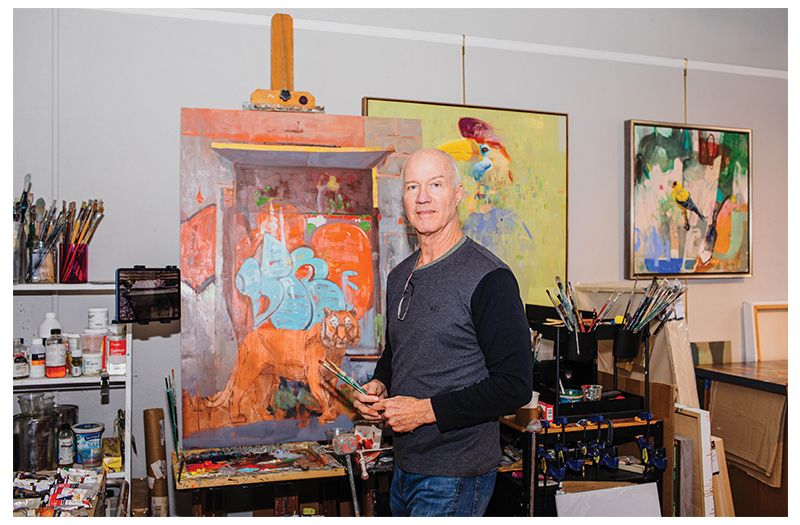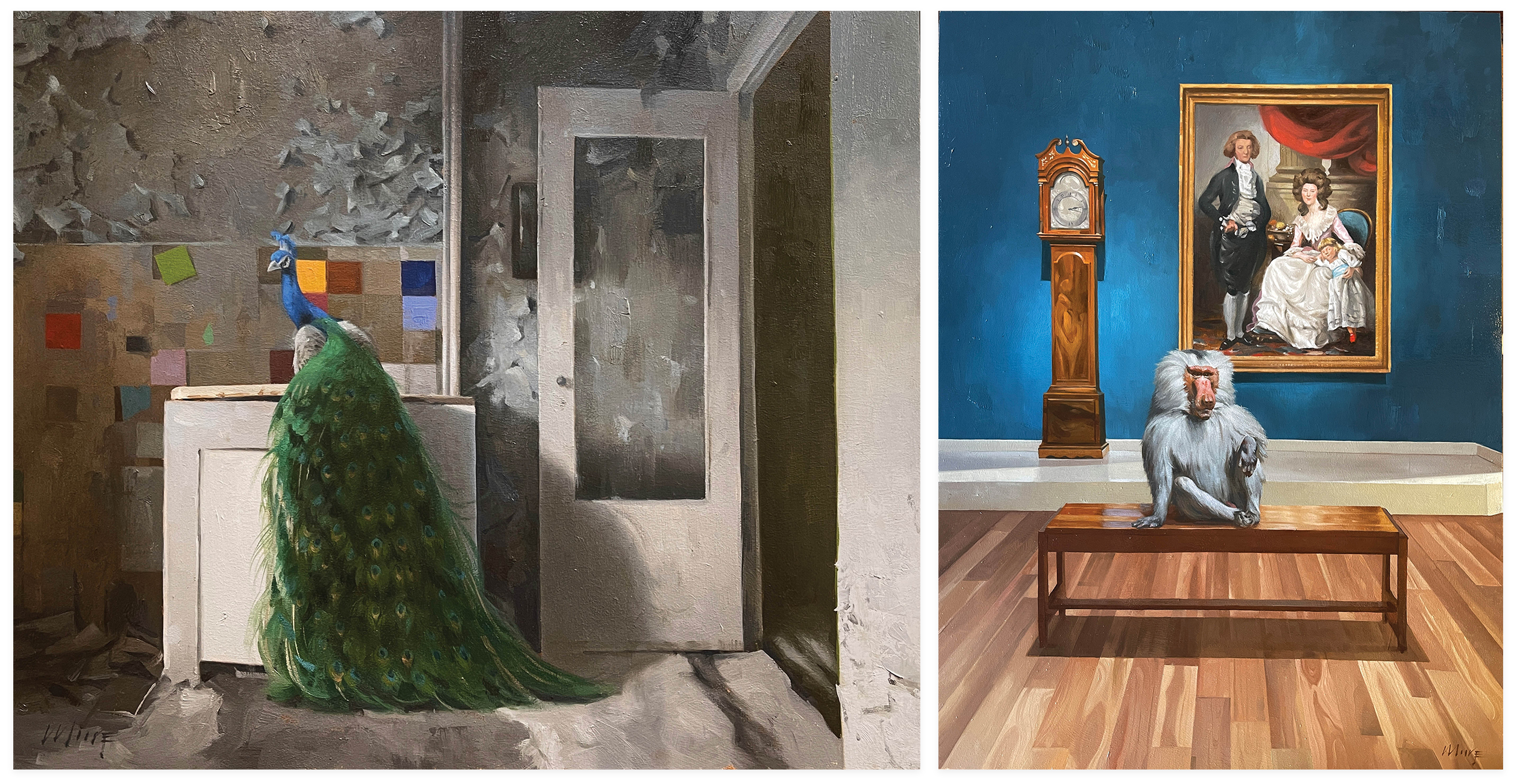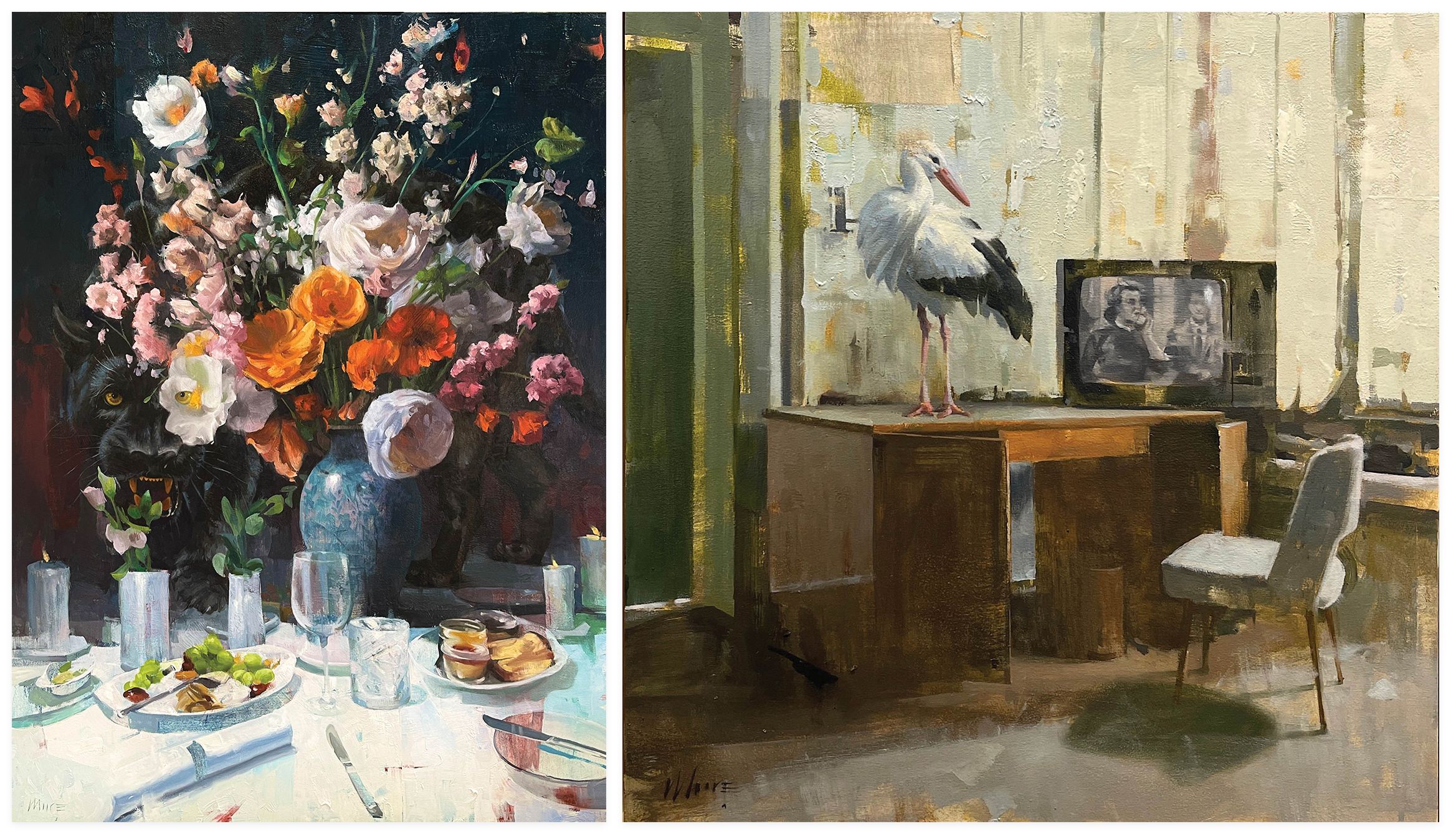See his work this month at the Southeastern Wildlife Exposition

The sometimes jarring juxtaposition of wild animals in unnatural environments characterizes artist Larry Moore’s “Intrusion” series, in which he raises questions about who’s intruding on whom.
In Larry Moore’s painting The Interaction of Color, a peacock perches on the edge of a sink, his vivid, majestic feathers a sharp contrast against the backdrop of a decrepit, gray kitchen. This work is part of his “Intrusion” series, in which Moore depicts exotic animals roaming through abandoned, dying buildings. A lifelong champion for the environment, Moore is asking the viewer to consider, “who is intruding on whom?”
The former graphic designer and illustrator can often be found painting at his home gallery in Charleston, Horton Hayes Fine Art, as well as this month at the Southeastern Wildlife Exposition. When not in town, he’s traveling the country teaching creative thinking, design, and composition, including local workshops in March and July. In 2015, he began writing a book called Fishing for Elephants to inspire authentic creativity in anyone. “The key components of the creative process can be learned by anyone but overcoming the fear of applying them, that’s the trick,” he writes on his website.
Here, Moore shares how he transitioned from graphic design to fine art and one of his recent projects, in which he discovered a creative connection with his late grandmother.
Light His Fire: I started drawing as a child, and everyone supported me because it gave me something to do. My mom won a big art kit in a television contest, and I started making my own T-shirts. When I ran out of paint, I got an airbrush and started painting murals, vans, and surfboards. In college, I majored in graphic design, and my mom decided I needed to go on a humanities tour of Europe. We traveled for six weeks, and I went to all the museums and historical sites. That really lit things on fire. I worked in graphic design and as an illustrator until 2005.

After moving to Charleston, artist Larry Moore began a series of animals in unusual places, including (right) Royalist (oil on wood, 30 x 40 inches, 2024) and (left) The Interaction of Color (oil on wood, 24 x 20 inches, 2024). See Moore’s work this month at SEWE.
Moving to Fine Art: I’d been painting since 1984, and in the late ’90s, there was a big demand for plein air art. I did plein air for 10 or 15 years, traveling around and painting, but it wasn’t a great way of making a living. Mark Horton encouraged me to move here in 2016, and I quickly realized I didn’t have to do the landscape thing. I started with the narrative of animals in abandoned places, and it went really well.
Making a Statement: I was doing a plein air event in Easton, Maryland, and they gave us access to a historical building that was going to be destroyed. It was an abandoned dry cleaner, and all the clothes were still there. I had this apocalyptic vision in my mind: if we disappear, the animals will come back. I started the series to make a statement about people and our not-so-great relationship to the environment. I use it now as a metaphor for something I want to get across. My one driver is I don’t want to repeat or paint something for commercial reasons. If there’s an idea, I’m interested. The series has morphed into two branches, classic “Intrusion” animals and animals in abstract places, which is more fun visually.

(Left) In Ego and the Id (oil on wood, 30 x 40 inches, 2024), Moore seems to ask whether impulse or the rational mind will conquer this pretty tablescape; (right) As the World Turns (oil on wood, 24 x 24 inches, 2024)
Teaching Creativity: I started teaching plein air in 1990 and realized I knew stuff from my career that most people don’t know, which is how to generate ideas. My book Fishing for Elephants came from an article I wrote about how not knowing how to do something shouldn’t stop you from doing it. I’m working on a sequel.
Artful Connections: My grandmother wrote a book in 1929 called Jackie Boy and the Sea Folk. The original artwork was lost in a hurricane in 1935, but my cousin found the original text and small black-and-white photographs of the art and asked me if I wanted to bring it back to life with her. It’s an adventure story about appreciating nature, so yes, I did. I put the images into Photoshop, cleaned them up, transferred them to watercolor paper, and spent two years recoloring them in the evenings. We did a GoFundMe, and now it’s published. Looking at her illustrations, the way she depicted the animals is spot on. My work is about appreciating nature while we still can and so was hers. That connection is kind of magical.